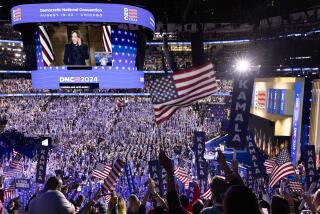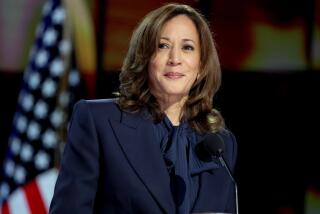Op-Ed: How do you protest at a virtual Democratic convention?
With the Democratic National Convention meeting virtually this year, the fate of another longstanding political tradition is also in jeopardy.
For decades, protesters have brought their issues to the streets of the Democratic convention’s host city, demanding that the party address controversial issues it might rather ignore. This year, the Coalition to March on the DNC is still planning a demonstration outside the convention hall to demand that “Joe Biden and the Democrats stop these killer cops who operate in Democrat-controlled cities like right here in Milwaukee.” But without delegates and without the candidates being present, it’s hard to imagine the kind of statement in the streets we’re used to seeing every four years.
And that’s a shame, because protests from the left have occasionally pushed the party to take stronger stances than it otherwise might have.
One of those times was in 1960, the year of the first big demonstrations at a Democratic convention. That year, the event was held in Los Angeles, and the party nominated John F. Kennedy and Lyndon B. Johnson at the brand-new Sports Arena. Outside the arena, Martin Luther King Jr. joined thousands of marchers picketing to demand a strong civil rights plank in the Democratic platform.
The 1960 convention, like this year’s, came after a season of unprecedented Black protest. Across the South, the Student Nonviolent Coordinating Committee had organized sit-ins at segregated lunch counters. (John Lewis’ first arrest was in Nashville for participating in such a sit-in.) Thousands of supporters in the North, Black and white, picketed in support outside their local Woolworth’s stores.
And in Los Angeles, on the eve of the convention, 7,500 people, most of them Black, gathered at the Shrine Auditorium to demand change at an event that the California Eagle, a Black weekly newspaper, described as the largest Negro political gathering since the 1940s. When Kennedy arrived at the Shrine that night, the crowd booed him. In contrast, Minnesota Sen. Hubert Humphrey, who had introduced the Democrats’ first civil rights plank at the 1948 convention, got a standing ovation. The key speakers were Martin Luther King Jr. and Adam Clayton Powell, Harlem’s outlaw congressman. Powell stole the show, as he almost always did with urban Black audiences.
After the stirring speeches, a determined crowd of 5,000 people, led by King, marched down Figueroa to the Sports Arena, where the Democratic Party chairman told them, “We dedicate ourselves to the elimination of all discriminatory practices at the earliest possible moment.” Black voices from the crowd pushed back, crying, “No! No! ... Not later. Now!”
SNCC representatives who came to L.A. in 1960 pushed hard for a party platform that faced “up to the reality that racial discrimination is America’s No. 1 social issue.” The group’s leaders insisted that “our national government should guarantee the fundamental rights of all citizens without discrimination,” calling for, among other things, protection for “the unhampered exercise to the franchise for all citizens.”
The party responded with the strongest civil rights statement it had ever included in its platform, noting that “the peaceful demonstrations for first-class citizenship which have recently taken place in many parts of this country are a signal to all of us to make good at long last the guarantees of our Constitution.” The 1960 platform recognized the party’s responsibility “to assure equal access for all Americans to all areas of community life, including voting booths, schoolrooms, jobs, housing, and public facilities.
Of course, that was 60 years ago, and today America’s No. 1 social issue remains the same. The unprecedented support for this year’s Black Lives Matter protests has shown clearly that civil rights still need to be at the top of the priority list for Democrats.
It’s too bad demonstrators won’t be able to hammer that message home to thousands of party representatives gathering for an actual convention.
Jon Wiener and Mike Davis are the authors of “Set the Night on Fire: L.A. in the Sixties.”
More to Read
A cure for the common opinion
Get thought-provoking perspectives with our weekly newsletter.
You may occasionally receive promotional content from the Los Angeles Times.










